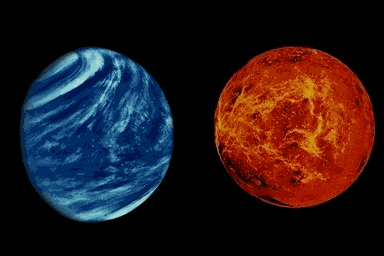
LAB 11
Venus & Earth
Hemispheric view of Venus centered at 180 degrees East longitude, showing color-coded topography overlain on Magellan radar image
|
|
LAB 11 Venus & Earth |
|
Hemispheric view of Venus centered at 180 degrees East longitude, showing color-coded topography overlain on Magellan radar image |
Objectives:
Earth and Venus are called "sister" planets because they are of similar size and density, implying that they are composed of similar material. Because of their similar size, composition, and age (both "born" 4.6 billion years ago, on a Thursday afternoon), we might expect that they operate in the same way. Our supposition couldn't be more incorrect! The NASA Magellan mission to Venus provides a wealth of data, including altimetry (surface elevation) and radar imagery (like black and white photographs) of 98% of the planet. We will be using the same NASA data used by planetary scientists in today’s lab. These data allow us to ask fundamental questions about how Venus formed and how it operates today. By looking at the Magellan data to learn something about our sister planet, we will gain a different perspective in our understanding of the Earth. This lab provides an excellent review of our own planet , how its spheres interact, and how they have changed through Earth’s 4.6 billion years of history. One very important question is, Why are these two seemingly similar terrestrial planets so different?Reading:
Skinner, Porter & Botkin, The Blue Planet Chap. 1: p.34-39.Useful web sites:
Views of the Solar System (LANL)
bang.lanl.gov/solarsys/eng/homepage.htmone on Magellan
Mars Pathfinder mission
mpfwww.jpl.nasa.gov/default.html
Background on the Magellan mission:
For part of this lab you will be looking at images of the surface features of Venus, brought to you by the 1989-92 NASA Magellan satellite. The Magellan mission to Venus returned radar images (Synthetic Aperture Radar, or SAR) of ~98% of Venus’ surface. The images have a resolution of ~100 meters (that is, we could see a football field, or an empty Olympic-size swimming pool on Venus if they existed, but we wouldn’t be able to see a tennis court). Radar was used to "see" through Venus’ thick atmosphere because visible light cannot penetrate its cloud cover (see below). For our purposes, we can view the radar images like black and white photographs. Rough areas reflect most of the radar signal back to the spacecraft and therefore they appear bright on the SAR images, whereas smooth areas do not reflect much of the radar signal back to the spacecraft (they act like a mirror reflecting the signal away from the spacecraft) and therefore these areas appear dark on the SAR images. In 1972 the former Soviet union landed the Venera 8 lander on the surface of Venus and was able to measure the bulk rock composition at several locations. In each case the data indicates a generally basaltic rock composition.
The dense, cloudy atmosphere of Venus in UV light as seen by Mariner I in 1974 (left). By observing with cloud-penetrating radar, as seen in the false-color image at right, the terrestrial surface of Venus is revealed, complete with volcanic features and impact craters. No evidence has been discovered to suggest that life ever existed on Venus.